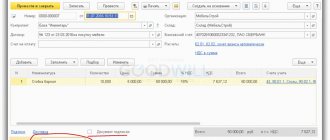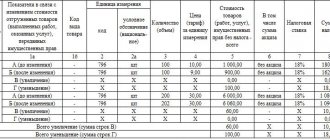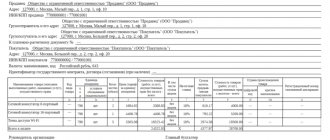When can you issue an invoice in foreign currency?
According to paragraph 7 of Art.
169 of the Tax Code of the Russian Federation, an invoice in foreign currency can be drawn up if the terms of the transaction in the contract are expressed in foreign currency. At the same time, in parallel with this norm of the Tax Code, there is another one in the legislation: sub-clause. "m" clause 1 section. Resolution II of the Government of the Russian Federation “On filling out documents for VAT calculations” dated December 26, 2011 No. 1137 states that if the obligation under the contract is fixed in currency equivalent, but the payment currency is rubles, the invoice should be issued in rubles. Thus, ambiguity arises when applying these rules to transactions between residents of the Russian Federation:
- on the one hand, it seems that it is possible to issue an invoice in foreign currency if the obligation is expressed in foreign currency (conventional units);
- on the other hand, this violates the procedure for issuing invoices according to the rules established for residents of the Russian Federation, which are necessary for their acceptance in tax accounting for VAT.
This point is actively used by tax authorities who check the legality of deducting VAT. The tax accepted for deduction on an invoice issued in foreign currency is not confirmed and an understatement of VAT is registered with all the ensuing consequences. From time to time, the Federal Tax Service reinforces its position with its own explanatory letters. For example, one of the latest - letter No. ED-4-3/12813 dated July 21, 2015 - once again refers to the procedure for issuing VAT documents, approved by Resolution No. 1137 (in rubles), as the only correct one.
NOTE! Buyers have problems with deductions for foreign currency invoices. Tax authorities usually do not try to apply any sanctions to the seller who issued documents in foreign currency. Exceptions occur only in cases where the seller, reflecting data in tax registers, incorrectly recalculated the amount of revenue in rubles on such invoices and thereby underestimated the VAT base.
Association of International Road Carriers
According to paragraph 7 of Art. 169 of the Tax Code of the Russian Federation, an invoice in foreign currency can be drawn up if the terms of the transaction in the contract are expressed in foreign currency. At the same time, in parallel with this norm of the Tax Code, there is another one in the legislation: sub-clause. "m" clause 1 section. Resolution II of the Government of the Russian Federation “On filling out documents for VAT calculations” dated December 26, 2011 No. 1137 states that if the obligation under the contract is fixed in currency equivalent, but the payment currency is rubles, the invoice should be issued in rubles.
Thus, ambiguity arises when applying these rules to transactions between residents of the Russian Federation:
· on the one hand, it seems that it is possible to issue an invoice in foreign currency if the obligation is expressed in foreign currency (conventional units);
· on the other hand, this violates the procedure for issuing invoices according to the rules established for residents of the Russian Federation, which are necessary for their acceptance in tax accounting for VAT.
This point is actively used by tax authorities who check the legality of deducting VAT. The tax accepted for deduction on an invoice issued in foreign currency is not confirmed and an understatement of VAT is registered with all the ensuing consequences. From time to time, the Federal Tax Service reinforces its position with its own explanatory letters. For example, one of the latest - letter No. ED-4-3/12813 dated July 21, 2015 - once again refers to the procedure for issuing VAT documents, approved by Resolution No. 1137 (in rubles), as the only correct one.
NOTE! Buyers have problems with deductions for foreign currency invoices. Tax authorities usually do not try to apply any sanctions to the seller who issued documents in foreign currency. Exceptions occur only in cases where the seller, reflecting data in tax registers, incorrectly recalculated the amount of revenue in rubles on such invoices and thereby underestimated the VAT base.
Who should issue an invoice in foreign currency?
If you look at the lawsuits in which VAT on foreign currency invoices was ultimately accepted for deduction, you can note that the peak occurred in 2011–2013. Then, by 2016–2017, the consideration of such cases practically disappeared.
Most likely, this is due to the fact that residents simply stopped filing VAT documents in foreign currency under agreements under which they are calculated in rubles.
Thus, the answer to the question “In general, is it possible for a resident of the Russian Federation to issue an invoice in foreign currency to a counterparty resident of the Russian Federation?” like this: theoretically possible, but not necessary. Unless, of course, the goal is to make it difficult for the resident partner to deduct VAT on such documents.
To whom exactly can VAT documents be issued in foreign currency?
1. To a counterparty (including a resident), with whom settlements are also carried out in foreign currency. This option is limited by the currency legislation of the Russian Federation. The list of transactions between residents of the Russian Federation that qualify for this option is listed in clause 1 of Art. 9 of the Law “On Currency Regulation” dated December 10, 2003 No. 173-FZ.
2. To yourself. For export transactions (for which the rate is 0%), the resident exporter is not exempt from the obligation to keep VAT records. The exporter must issue an invoice (with zero VAT) and register it in the sales ledger.
How to issue a foreign currency invoice in 2017–2018
Let's consider the nuances of drawing up a foreign currency invoice from the seller:
· line 7 - enter the name and currency code of the account (according to OKV - the All-Russian Classifier of Currencies);
· then the “standard” lines of the document are filled in in the specified currency.
As you can see, it is not so difficult for the seller to issue an invoice. Questions usually arise at the stage of deciding whether the document will be in foreign currency or in rubles.
IMPORTANT! You can enter additional information into the currency invoice. This is allowed to be done between line 7 and the rest of the tabular part to be filled in, as well as in the tabular part itself, provided that the form of the invoice is preserved and the sequence of filling out its columns is not disrupted. This rule is enshrined in Federal Tax Service letter No. SD-4-3/ [email protected] and is especially relevant for those who work with counterparties in the EAEU. This letter was issued before additional line 8 “Government contract identifier (if any)” was introduced into the invoice form, therefore we believe that additional information must be indicated without violating the structure of the invoice between line 8 and the tabular part.
Let us remind you that from July 1, 2016, it is mandatory to indicate the product code in invoices to a counterparty in the EAEU in accordance with the unified product nomenclature of the EAEU. The product code is indicated in column 1a “Product type code” of the tabular part of the invoice, applicable from 10/01/2017. Until October 2021, the code of the type of goods when exported to the EAEU was indicated in the invoice in a self-entered column.
Results
The general procedure for issuing an invoice in foreign currency has some nuances, but overall it is not difficult. Doubts may arise when deciding whether the document to be written should be in foreign currency or whether it is better to issue it in rubles.
How should invoices and invoices be drawn up (in rubles, foreign currency or conventional units) if an agreement with a counterparty from the Republic of Kazakhstan will be concluded in foreign currency or conventional units?
The parties have the right to set the contract price both in foreign currency and in conventional monetary units. Registration of primary documents in foreign currency or in conventional monetary units can lead to tax disputes. Drawing up an invoice in foreign currency is only possible if the foreign buyer makes payment in foreign currency.
Rationale for the conclusion: In accordance with paragraph 1 of Art. 1210 of the Civil Code of the Russian Federation, the parties to an agreement, when concluding it or subsequently, can choose, by agreement among themselves, the law (Russian or foreign) that is subject to application to their rights and obligations under this agreement. As a general rule, in the absence of an agreement between the parties on the applicable law, the law of the country where, at the time of conclusion of the contract, is the place of residence or the main place of activity of the party that carries out the performance, which is decisive for the content of the contract, is applied to the contract (clause 1 of Article 1211 of the Civil Code of the Russian Federation ). In particular, the party that performs the performance, which is decisive for the content of the contract, in the purchase and sale agreement is the seller (clause 1, clause 2, article 1211 of the Civil Code of the Russian Federation). Since your organization acts as a seller, the analyzed situation will be considered by us on the basis of the provisions of Russian legislation. The ruble is legal tender, obligatory for acceptance at face value throughout the Russian Federation (Clause 1, Article 140 of the Civil Code of the Russian Federation). Cases of using foreign currency in settlements on the territory of the Russian Federation are determined by law (clause 2 of Article 140 of the Civil Code of the Russian Federation). Thus, settlements between residents and non-residents can be carried out in foreign currency (Article 6 of the Federal Law of December 10, 2003 N 173-FZ “On Currency Regulation and Currency Control”). In this case, the parties to the agreement have the right to indicate in the agreement the currency of the debt in foreign currency or conventional monetary units (clause 2 of Article 317 of the Civil Code of the Russian Federation). Thus, we believe that your organization and the buyer from the Republic of Kazakhstan have the right to set the contract price both in foreign currency and in conventional monetary units.
Preparation of invoice
According to paragraphs. 6.1 clause 5 and clauses 4.1 clause 5.1 art. 169 of the Tax Code of the Russian Federation, the name of the currency is a mandatory detail of the invoice. By virtue of paragraphs. “m” clause 1 of the Rules for filling out an invoice used in calculations for value added tax (Appendix 1 to the Decree of the Government of the Russian Federation of December 26, 2011 N 1137), line 7 of the invoice indicates the name of the currency, which is the same for all goods (works, services) listed in the invoice, property rights and its digital code in accordance with the All-Russian Classifier of Currencies, including for non-cash forms of payment. When selling goods (work, services), property rights under contracts, the obligation to pay for which is provided in Russian rubles in an amount equivalent to a certain amount in foreign currency or in conventional monetary units, the name and code of the currency of the Russian Federation are indicated. Consequently, if an agreement was concluded with a counterparty in foreign currency (conventional monetary units), and the payment obligation is fulfilled in Russian rubles, then invoices must be issued in Russian rubles. In turn, clause 7 of Art. 169 of the Tax Code of the Russian Federation provides that if, under the terms of the transaction, the obligation is expressed in foreign currency, then the amounts indicated in the invoice can be expressed in foreign currency. The above, in our opinion, means that if a currency agreement has been concluded with a counterparty and the payment obligation will also be fulfilled in foreign currency, then invoices are issued in the same currency. In this case, line 7 of the invoice must contain the code of the currency in which settlements with the buyer will be made. This situation can only arise in settlements with foreign counterparties.
Who should issue an invoice in foreign currency?
If you look at the lawsuits in which VAT on foreign currency invoices was ultimately accepted for deduction, you can note that the peak occurred in 2011–2013. Then, by 2016–2017, the consideration of such cases practically disappeared.
Most likely, this is due to the fact that residents simply stopped filing VAT documents in foreign currency under agreements under which they are calculated in rubles.
Thus, the answer to the question “In general, is it possible for a resident of the Russian Federation to issue an invoice in foreign currency to a counterparty resident of the Russian Federation?” like this: theoretically possible, but not necessary. Unless, of course, the goal is to make it difficult for the resident partner to deduct VAT on such documents.
To whom exactly can VAT documents be issued in foreign currency?
1. To a counterparty (including a resident), with whom settlements are also carried out in foreign currency. This option is limited by the currency legislation of the Russian Federation. The list of transactions between residents of the Russian Federation that qualify for this option is listed in clause 1 of Art. 9 of the Law “On Currency Regulation” dated December 10, 2003 No. 173-FZ.
2. To yourself. For export transactions (for which the rate is 0%), the resident exporter is not exempt from the obligation to keep VAT records. The exporter must issue an invoice (with zero VAT) and register it in the sales ledger.
The moment of determining the tax base is the day of payment
The situation is different when the contract contains a provision for advance payment. In this case, the contractor will have to recalculate the received currency into rubles twice, focusing on the exchange rate on the dates of receipt of the advance payment and completion of the work ( clause 14 of Article 167 of the Tax Code of the Russian Federation ).
In order to establish the moment of determining the tax base for VAT, the day of performance of work (provision of services), that is, the day of shipment, is recognized as the date of signing the acceptance certificate of work (services) by the customer.
Having calculated the “advance” VAT from the received prepayment, the contractor will issue an “advance” invoice and register the document in the sales book (similarly to how shown in example 2).
Subsequently, upon completion of construction and signing of the acceptance certificate for the completed construction facility, the contractor will again calculate VAT, issue a “shipping” invoice, register the document in the sales book, and “advance” VAT (by virtue of clause 8 of Article 171 of the Tax Code of the Russian Federation ) will be taken into account. “Advance” VAT is subject to deduction in the amount of tax calculated from the cost of goods shipped (work performed, services rendered), transferred property rights, in payment of which the amount of previously received payment, partial payment according to the terms of the contract (if such conditions exist) are subject to offset ( p 6 Article 172 of the Tax Code of the Russian Federation ).
Example 3
Let us slightly modify the conditions of example 1. Let us assume that the contract provides for a 100% prepayment, which the contractor received in the amount of 17,700 euros on 05/04/2017 (the exchange rate on that day was 62.32 rubles/euro).
The work acceptance certificate was signed on October 24, 2017. The euro exchange rate against the Russian ruble on this date was 67.56 rubles/euro.
The following entries were made in the contractor's accounting records:
| Contents of operation | Debit | Credit | Amount, rub. |
| 04.05.2017 | |||
| An advance payment was received for subsequent construction work. (17,700 euros x 62.32 rubles/euro) | 52 | 62 | 1 103 064 |
| “Advance” VAT charged* (2,700 euros x 62.32 rubles/euro) | 76‑av | 68 | 168 264 |
| 24.10.2017 | |||
| Accounting revenue is reflected based on the exchange rate valid on the date of receipt of the advance** (17,700 euros x 62.32 rubles/euro) | 62 | 90-1 | 1 103 064 |
| "Shipping" VAT is reflected*** (2,700 euros x 67.56 rubles/euro) | 90-3 | 68 | 182 412 |
| “Advance” VAT**** accepted for deduction | 68 | 76‑av | 168 264 |
* The “advance” invoice is reflected in the sales book for the second quarter of 2017 (we present only the columns that interest us):
| Column No. | Index |
| 13a | 17,700 (euros, 978) |
| 14 | 934,800 (RUB) |
| 17 | 168,264 (RUB) |
** In accounting, the amounts of received advance payment are not subject to further revaluation. The seller's income is recognized in rubles at the rate in effect on the date of conversion of the received prepayment into rubles, as indicated by clause 9 of PBU 3/2006 .
*** Despite the fact that in accounting on the date of signing the certificate of completion of work, revenue is recognized in the amount of the prepayment received, for VAT purposes this is subject to recalculation on the date of completion of the work ( clause 3 of article 153 , clause 14 of article 167 of the Tax Code RF ). Accordingly, the contractor will recalculate foreign currency earnings as of October 24, 2017 (17,700 euros x 67.56 rubles/euro = 1,195,812 rubles) and determine the amount of tax payable on the volume of work performed (2,700 euros x 67.56 rubles. /euro = 182,412 rubles).
He will record the “shipping” invoice in the sales book, in which the columns of interest to us will be filled in as follows:
| Column No. | Index |
| 13a | 17,700 (euros, 978) |
| 14 | 1,013,400 (RUB) |
| 17 | 182,412 (RUB) |
**** Since the taxpayer has the right to deduct VAT paid on prepayment, he will reflect the “advance” invoice in the purchase book ( clause 22 of the Rules for maintaining the purchase book ).
How to issue a foreign currency invoice in 2020-2021
Let's consider the nuances of drawing up a foreign currency invoice from the seller:
- line 7 - enter the name and currency code of the account (according to OKV - the All-Russian Classifier of Currencies);
- then the “standard” lines of the document are filled in in the specified currency.
As you can see, it is not so difficult for the seller to issue an invoice. Questions usually arise at the stage of deciding whether the document will be in foreign currency or in rubles.
IMPORTANT! You can enter additional information into the currency invoice. This is allowed to be done between line 7 and the rest of the tabular part to be filled in, as well as in the tabular part itself, provided that the form of the invoice is preserved and the sequence of filling out its columns is not disrupted. This rule is enshrined in Federal Tax Service letter No. SD-4-3/ [email protected] and is especially relevant for those who work with counterparties in the EAEU. This letter was issued before additional line 8 “Government contract identifier (if any)” was introduced into the invoice form, therefore we believe that additional information must be indicated without violating the structure of the invoice between line 8 and the tabular part.
Let us remind you that from July 1, 2016, it is mandatory to indicate the product code in invoices to a counterparty in the EAEU in accordance with the unified product nomenclature of the EAEU. The product code is indicated in column 1a “Product type code” of the tabular part of the invoice, applicable from 10/01/2017. Until October 2021, the code of the type of goods when exported to the EAEU was indicated in the invoice in a self-entered column.
For more details, see: “Export to the EAEU: where to indicate the code of non-taxable goods in the invoice?” .
ConsultantPlus experts explained which codes to indicate on the invoice. To avoid mistakes, get trial access to the system and go to the Ready-made solution.
How to generate invoices in foreign currency in 1C
First of all, it is necessary that the “Currencies” directory be filled out in “1C”. You can select the desired currency or add it manually.
NOTE! If the terms of the agreement provide for a “special” conversion into rubles (a currency clause has been made), for example, “payment at the rate of 1 euro plus 3%,” then you can enter the following new position into the directory:
- create a “new currency”;
- link to the euro exchange rate (check the box in the form that opens);
- set the required “surcharge”;
- save with a name that will allow you to quickly find the position if necessary.
Read about the nuances of currency clauses in the article “Sample of a currency clause in a contract and its types .
Then you need to correctly enter information about the contract into the database. In the “Calculations” section of the contract being drawn up, you need to select the desired currency from the directory. Save changes.
When entering a document (for example, a sale) under an agreement, the required currency will be automatically selected and converted into rubles at a given rate for accounting purposes.
The easiest way to issue an invoice is through the “Create based on” option, which is available in all accounts receivable documents. The invoice created on the basis of the source document (sale or payment) will automatically take into account all the nuances of the reflected transaction, including the currency of the contract.
Branch of a foreign company – VAT payer
Let us first inform you: a branch or representative office of a foreign legal entity established on the territory of the Russian Federation is recognized as VAT payer organizations (see paragraph 2 of Article 11 , Article 143 of the Tax Code of the Russian Federation ), which have rights and perform duties in accordance with the tax legislation of the Russian Federation Federations are on a par with Russian organizations if they are registered with the tax authority as a taxpayer. The Federal Tax Service recalled this in Letter No. SD-18-3/1011 dated September 29, 2016, and here also noted that taxpayers are foreign organizations that are not registered with the tax authorities as a taxpayer, the total amount of VAT by virtue of clause 3 of Art. 166 of the Tax Code of the Russian Federation are not calculated.
In the case we are considering, a branch of a foreign company (contractor) is a VAT payer and acts in accordance with the norms provided for in Chapter. 21 Tax Code of the Russian Federation . The contractor will determine the tax base taking into account clause 3 of Art. 153 of the Tax Code of the Russian Federation : revenue received in foreign currency will be converted into rubles at the rate of the Central Bank of the Russian Federation. The date of recalculation corresponds to the moment of determining the tax base for the sale (transfer) of goods (work, services), property rights, established by Art. 167 of the Tax Code of the Russian Federation , as the earliest of the following dates:
1) the day of shipment (transfer) of goods (work, services), property rights;
2) the day of payment, partial payment for upcoming deliveries of goods (performance of work, provision of services), transfer of property rights.






